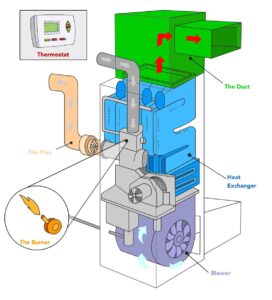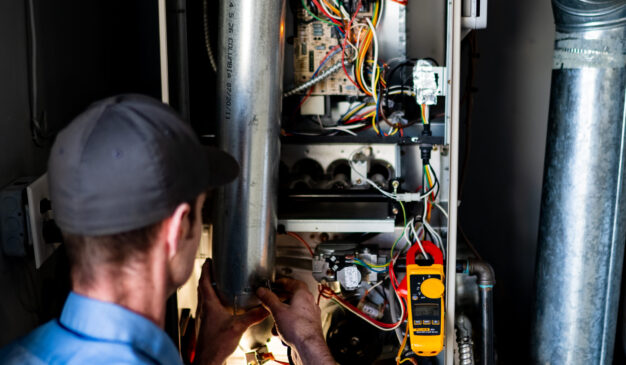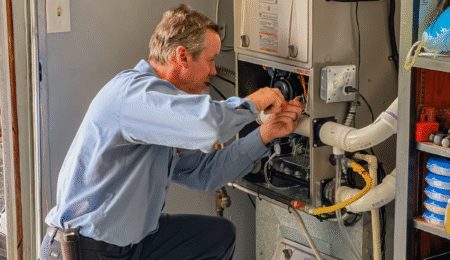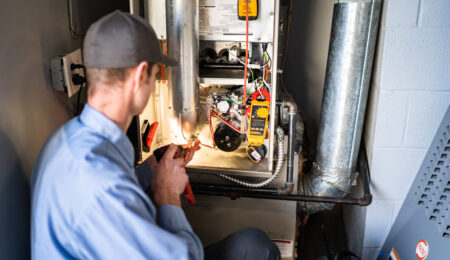Everything You Need to Know About Furnaces
If you live in Western Washington, you know how important a reliable heating system is—especially during those damp, chilly months. Whether your furnace is on its last leg or you’re just trying to stay informed, this guide covers what you need to know to stay warm and worry-free.
What Is a Furnace?
A furnace is the heart of your home’s heating system. It takes in air, warms it up, and circulates it throughout your home using ducts. Most homes in our region rely on gas or electric furnaces, although oil furnaces are still used in some older homes.
How Does a Furnace Work?
Whether gas or electric, a furnace works by pulling in cool air from your home, warming it up, and circulating it throughout your home to keep you comfortable.

This furnace diagram shows how a gas heating system moves air through your home, highlighting key parts like the burner, heat exchanger, and blower.
Gas Furnaces
In a gas furnace, natural gas is ignited in the burner. The flames heat up a component called the heat exchanger, which warms the air. A blower fan then pushes that warm air through your home’s ductwork. Gas furnaces are known for delivering quick, powerful heat—especially handy during cold snaps in Western Washington.
Electric Furnaces
Electric furnaces generate heat using electric resistance coils—similar to the elements in a toaster. When electricity flows through the coils, they heat up, and a built-in blower pushes warm air through your home’s ductwork.
Important to note: Electric furnaces are often mistaken for air handlers. While both may look similar and include a blower, only electric furnaces produce heat on their own. Air handlers, by contrast, work with a heat pump and don’t generate heat independently.
Both types are effective for keeping your home warm—your choice often depends on whether your home is set up for natural gas or runs entirely on electricity.
When to Choose Gas or Electric: Furnace Applications for Your Home
Choosing between a gas or electric furnace isn’t just about cost—it’s about what works best for your home, your energy setup, and your comfort needs.
🔥 Gas Furnaces: Ideal for Most Western Washington Homes
Gas furnaces are a popular choice in Western Washington—especially in areas with access to natural gas lines like Tacoma, Olympia, Puyallup, and surrounding cities. Here’s when a gas furnace makes the most sense:
-
You already have natural gas service: If your home is already connected, a gas furnace is typically the most efficient and cost-effective option.
-
You want strong heat output: Gas systems produce higher temperatures quickly, which can be especially useful during cold snaps.
-
You’re focused on long-term operating savings: Although installation may cost more upfront, natural gas is usually more affordable than electricity in the long run.
⚡ Electric Furnaces: A Solid Option for All-Electric Homes or Rural Areas
Electric furnaces are a reliable alternative for homes that don’t have access to natural gas or are built to run on all-electric systems. You might consider an electric furnace if:
-
You live in a more rural or remote area where gas lines aren’t available.
-
You prefer a lower upfront cost: Electric furnaces typically cost less to install than gas systems.
-
You’re prioritizing safety and maintenance simplicity: Electric furnaces don’t involve combustion, so there’s no risk of gas leaks or carbon monoxide—plus, they tend to be easier to maintain.
Need Help Choosing the Right Furnace?
Whether you’re upgrading an older system or weighing the benefits of gas vs. electric, Pacific Heating & Cooling is here to help. Our experienced team will assess your home’s setup, comfort needs, and energy goals to recommend the best-fit solution—with upfront pricing and expert installation you can count on. Contact us today to schedule a free quote or learn more about your options.
Contact Us


